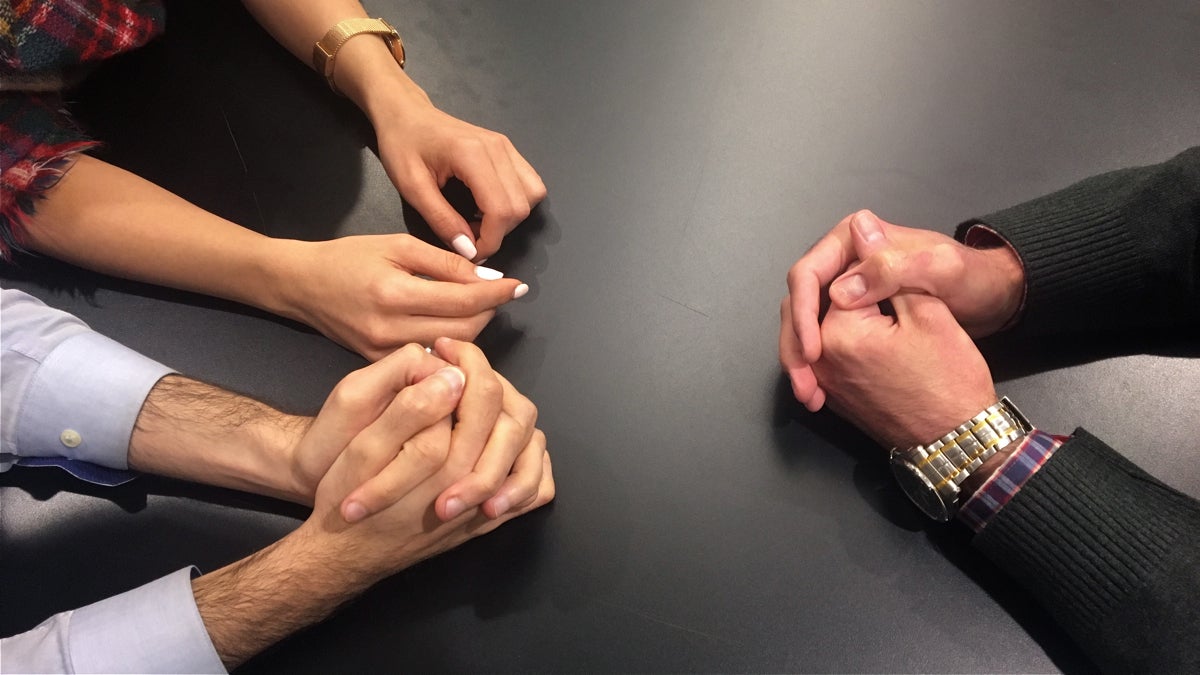Travel ban adds stress to ‘Match Week’ for these Iranian medical residency applicants
Listen
Medical graduates from Iran, in Philadelphia on research fellowships, anxiously await results of their U.S. medical residency applications. The Trump administration's immigration executive order has put an added stressor on 'match week' for them. (Elana Gordon/WHYY)
Amin knew he wanted to work in medicine from an early age. He recalled how growing up in Iran, he’d watch his dad experience seizures and his mom struggle to manage that care. He went on to medical school, then practiced at a rural clinic, all the while working toward an important point in his career, one that culminates next week: applying to match in a U.S. residency training program.
“I decided to come here to have better opportunities for research and clinical education, to hopefully share this information and these skills for the people who need this in the undeveloped countries,” Amin said.
Amin, who is already in Philadelphia on a research visa doing post doctoral research at Thomas Jefferson University, hopes to train in neurology with a focus on epilepsy. For international medical graduates like him, becoming eligible for residency training in the U.S. is a rigorous process that can take years of planning, financing and work. In general, landing one of these coveted spots, a requirement for anyone aspiring to train and practice medicine in the U.S., is already competitive; about 32,000 slots are available to an applicant pool of 42,000. Last year, about half of foreign medical graduate applicants matched.
But now as he braces for this much anticipated “match week” in which those decisions are released, he and others worry the recent White House executive orders on immigration have further diminished his chances of being matched.
“It becomes like double stress,” said Amin (NewsWorks agreed to only use his first name because of uncertainty around his future visa and match status).
“Yeah, I’m worried as well,” echoed Koosha, a post doctoral research fellow at Penn who is also from Iran and is awaiting a match decision. “I cannot clarify how much or describe to what extent it’s going to affect our chances, but I think it does.”
The two are not alone. For the approximate 1,000 medical residency applicants this year from countries included in the first or second executive order, an added cloud of uncertainty looms over what is typically an exciting moment in medical education.
“It is a valid concern,” said Dr. William Pinsky, president of the Educational Commission for Foreign Medical Graduates, or ECFMG.
Pinsky said the executive orders have created new unknowns in the visa process for foreign medical graduates, and as a result, puts these applicants and the residency programs themselves in a bind. While programs rank applicants based on their merits and qualifications, they also rely on them being available and ready to fill those clinical spots come July, in order to both train and care for patients. Many can’t afford to have an empty seat because of visa processing delays.
“I surmise and have talked to a few program directors that were probably going to rank individuals from these countries lower on their preference order than they would have otherwise,” Pinsky said.
He estimates 300 to 400 applicants this year from one of the seven countries in the executive orders will need consideration for a visa. About 1800 people from the seven countries are currently in medical residencies in the United States.
Compounding this year’s match, most residency programs ranked their preferences of applicants on February 22, in between the issuing of the first and second orders. Those decisions are then released Friday, March 17.
“The timing and uncertainty of the executive order could not have come at a worse time” according to Pinsky, who added that Iraq had not been removed from the list at the time the decisions were made, potentially adversely affecting applicants from that country. “Program directors have to weigh various factors of applicants, from their medical knowledge, ability to communicate, their observed level of empathy, their leadership capabilities, and their ability to be available when July 1 comes.”
ECFMG, which is based in Philadelphia, is responsible for certifying all international graduates who wish to apply for residency and practice medicine in the U.S. This involves administering qualifying exams and overseeing other background checks. ECFMG is also closely involved in the visa process, as a main sponsor of J1-clinical visas for international graduates, the most common type for training and practicing medicine in the U.S. A smaller number of institutions may directly sponsor residents through an H1B visa.
The first White House executive order came out in January and applied to seven Muslim majority countries: Iran, Iraq, Libya, Somalia, Sudan, Syria and Yemen. The new version, announced in early March, removed Iraq from the list. It bans new visas from the remaining six countries for 90 days, but it also includes more exceptions for U.S. entry, such as for lawful permanent residents in the U.S. and those with other valid documents.
“If someone has a visa, as I understand, even though they’re from one of these six countries, it’s not an issue,” said Pinsky.
Even so, he said some future visa scenarios are still unclear, as is the speed at which visas will be processed. He and others, for example, are trying to navigate an unclear landscape for those needing to convert visas to something more appropriate for their training program. They’re awaiting clarification from the federal government on that process, whether it will be allowed, and whether like before, the process can be expedited in order to be completed by the start of residency.
Programs that heavily rely on foreign medical graduates are uneasy.
Dr. Robert Wimmer heads a small pediatric residency program at Einstein Medical Center in North Philadelphia. He said the hospital depends on foreign medical graduates, which comprise about half of the residents there. Still, he said the program can’t afford to accept someone in their new class of ten if there’s a chance they might not be able to start come July because of visa issues.
“It’s unfortunate. Many work their tails off to get to the U.S. We might be losing a lot of talent,” Dr. Wimmer said, adding that only a small handful of the 2,000 applications they received were from one of the affected countries. “We’re just not willing to take any risk. It creates a hole for us in our program and what we’re able to do here in North Philadelphia.”
This may be less of an issue for larger academic centers, according to Atul Grover, vice president of the Association of American Medical Colleges.
“I think our bigger institutions, like Penn and CHOP, have very much said just on principle we’re going to rank these people if we think these are the best people,” Grover said. “You know if I’m Penn and I’ve got an internal medicine class of like 45 residents, maybe I can take more of a chance. If one resident doesn’t come maybe I can figure it out. But you can’t afford to lose 10 or 25 percent of your class. It’d be a big gamble for them.”
A spokesperson from Penn said they don’t think the executive order will impact their ability to train residents who match there.
Even so, Grover also worries about the bigger “psychological” impact of the executive orders, and the added strain it may place on the health system.
Many international graduates who are already medical residents and even have permanent visas aren’t traveling, according to Dr. Wimmer. They’ve canceled plans to see family abroad since the executive orders were announced as an additional layer of caution.
“They don’t know what’s coming next,” said Dr. Michael Stephen, associate professor of medicine and director of adult cystic fibrosis at Drexel University College of Medicine, referring to future immigration policies and questions about what might happen once the three month ban is up. “A lot of residents from all over the world have a lot of concerns. And that could harm the health system.”
About one quarter of the physicians in the U.S., are international. Medical education leaders say they often fill gaps in care in areas that other doctors might not want to. And while the United States has long held a reputation as an epicenter for top medical research and care, Pinsky, with ECFMG, worries that reputation and system could suffer, as an uncertain immigration climate may discourage people from trying to train and practice in the United States.
“The real downside is we could potentially be losing qualified people, and there won’t be numbers to fill in the positions,” Pinsky said. “So there could be an issue of access to health care as well as a quality situation.”
As for Amin and some of his Iranian peers, they’re trying to stay positive.
They feel encouraged by the support they’ve received from colleagues and their universities.
“One of the things that makes the academic environment in the U.S. unique is that many of the people here, the program directors, are very open minded, who just consider science as an entity that has no borders, that has no limits on it,” Koosha said.
Still Amin can’t help but think about the unanticipated uncertainties in this critical moment.
“When you try so hard to get to your dream and all of a sudden you feel that there are some issues, like unexpected problems, it’s a really bad feeling.”
WHYY is your source for fact-based, in-depth journalism and information. As a nonprofit organization, we rely on financial support from readers like you. Please give today.



